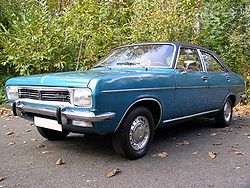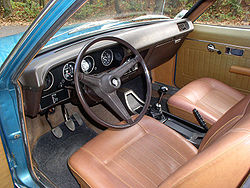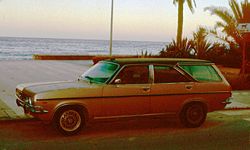- Chrysler 180
-
Chrysler 180 
Manufacturer Chrysler Europe Also called Chrysler 160/180/2 litre
Chrysler-Simca 1609/1610/2 litres
Talbot 1610/2 litresProduction 1970–1982 Predecessor Simca 1501
Humber Hawk
Chrysler ValiantSuccessor Talbot Tagora Class Large car Body style 4-door saloon Layout FR layout Engine 1.6 L Type 180 I4
1.8 L Type 180 I4
2.0 L Type 180 I4
1.9 L Barreiros diesel I4
2.0 L Barreiros diesel I4Transmission 4-speed manual
3-speed automaticWheelbase 2,667 mm (105.0 in)[1] Length 4,520 mm (178.0 in)[1] Width 1,730 mm (68.1 in)[1] Height 1,430 mm (56.3 in)[1] Related Chrysler Centura Designer Roy Axe
Curt GwinnThe Chrysler 180 was the base name for a series of large saloon cars produced by Chrysler Europe. Resulting from joining development efforts of Rootes Group and Simca, the car was produced from 1970 to 1975 in Poissy, France, and later in Chrysler's subsidiary Barreiros' factory in Spain. The Chrysler 180 was also the base for the medium-sized model built by Chrysler Australia, the Chrysler Centura.
Depending on engine employed, the cars were marketed as Chrysler 160/180/2 litre, and since 1977 in France and rest of continental Europe as Chrysler-Simca 1609/1610/2 litres. After the takeover of Chrysler Europe by PSA Peugeot Citroën, the continental Europe models were renamed Talbot 1610/2 litres for 1979 and 1980 model years, after which the model was discontinued in Europe save for Spain, where a diesel model was sold until 1982.
The large Chrysler fared quite poorly in the principal European markets. The replacement for the car was developed by Chrysler Europe under the codename C9 and was finally launched by PSA as the even more ill-fated Talbot Tagora.[2]
Contents
Development
Although Chrysler gradually took financial control of both Simca and Rootes Group during the 1960s, there was little effort to coordinate the operations of both automakers. Therefore, the first "common" European Chrysler car was actually a result of two separate development programmes.[3]
Rootes Group C Car
In 1966, under the direction of Roy Axe, the Head of Design, Rootes Group team started working on what was internally named the "C Car" (in reference to the smaller "B car", which became the Hillman Avenger), a new large car for Rootes to replace the Humber Hawk (and the imported Australian Chrysler Valiant, which served as a placeholder in Rootes' lineup after the Hawk's demise in 1967, without much success). In a typical Rootes fashion, the plan was to market the car under three brands - the base version as Hillman, a 2.0 litre one as Sunbeam 2000, and atop the range a Humber Hawk with a 2.5 litre engine. A further development of the C Car with a stretched platform was planned, a "D Car", which was to replace the Humber Super Snipe.[3]
The Rootes development programme also comprised the development of a brand-new V6 engine, with a 60° vee angle, with two versions of the abovementioned displacements of 2.0 and 2.5 litres. There were four (Series IV, presumably) Humber Hawk- and some Hillman Avenger-bodied prototypes built to test the new engine. Some other design propositions included the use of De Dion tubes for rear suspension (like in the competing Rover P6), as well as a five-speed gearbox (which would still be a rather daring proposition at that time).[3]
Simca Projet 929
At the same time, in France, Simca was working on Projet 929, which would be Simca's first large car since the Vedette was cancelled in 1961, and also partially replace the Simca 1501 in its role of the range-topping Simca. The car would not use a V6 engine, as the displacement-based puissance fiscale tax system in France would make the costs prohibitive, but rather four-cylinder units of more modest specifications. There were three styling propositions prepared for the new car. The 929 XA was styled by Simca's design team, featuring angular design and rather top-heavy proportions. Bertone designed the 929 XB, which was much more rounded and somewhat reminiscent of contemporary BMWs. Finally, the 929 XC was sent straight from Chrysler's Detroit design studios, and was very American in style, somewhat resembling a smaller version what later became the Australian VE Series Chrysler Valiant.[3][4]
The decision
In early 1969, Chrysler realized that there were actually two potentially competing cars being developed and called for both the British and the French proposition to be presented before the general management of Chrysler Europe. The decision was taken to go ahead with the British C Car programme, but to develop two versions for both the UK and the French part of the concern. Chrysler funded a new plant along with a development centre for the Rootes Group at the Whitley plant, Coventry, where the development was continued. Roy Axe employed former Chrysler USA designer Curt Gwinn as project designer, and the C Car took a shape very similar to an enlarged version of Hillman Avenger. Initial designs were inspired by contemporary American Chryslers, with twin headlamps and a light bar in the rear.[3]
In 1970, however, Chrysler reviewed the programme once again and decided to trim it down to just one version, to be built in Simca's Poissy factory in France, for all markets. The responsibility for the programme was then passed in turn to Simca (where it became known internally as "Simca 1800"), who gave the car a different front end with rectangular single front lamps, as well as stripped the interior of some features proposed by the Rootes Group team, such as genuine wood and leather and air conditioning. Much to the shock of the British engineers, the entire V6 engine programme was scrapped, even despite allegedly £31 million of the £38 million of the programme budget was already spent, and the tooling for the new engine was already being installed in the Rootes' Humber Road factory. The car also ended up with more conventional coil sprung rear live axle and MacPherson struts in the front and a four-speed manual transmission (with an option of a three-speed automatic).[3]
Marketing
Launch
Following the renaming of Simca to "Chrysler France" and Rootes Group to "Chrysler UK" (which combined formed Chrysler Europe), the new large car was the first one to spearhead the concept of unifying the offerings from both sides of the Channel under the common brand. Thus, the vehicle was launched as Chrysler 160, 160 GT and 180. In a fashion similar to Simca models, the designations referred to the displacement of the engines employed by the given version. The 160 employed the 1632 cc unit, while the 180 came with the 1812 cc one. A bit confusingly, the 160 GT came with the latter.[3]
The three models were introduced to the public at the 1970 Salon International d'Automobile under the slogan " An American from Paris". The British launch took place in 1971, with only the 180 on offer. The 2.0 litre model (marketed simply as "Chrysler 2 litre") joined the lineup for 1973, unveiled at the Amsterdam Auto Show in 1972 for the first time. The 1981 cc unit was available solely with Chrysler's TorqueFlite automatic transmission ( which was an option on the 180 model), and the model came with a host of features that distinguished it from the lesser versions, including a full-length vinyl roof (which became an option for the 160 and 180), bumper-mounted auxiliary driving lights and a small "2L" badge adorning the C-pillar. The 160 and 180 also gained some chrome and metal trim on the outside in 1972, and since the advent of the 2.0 litre, all models featured 14 inch (rather than previous 13 inch) wheels and new hubcaps. The 160 GT was cancelled at the same time.[3]
Press reaction
A Chrysler 180 saloon tested by the British Motor magazine in April 1971, a few months after the model's UK launch, had a top speed of 101.0 mph (162.5 km/h) and could accelerate from 0-60 mph (97 km/h) in 12.4 seconds. An overall fuel consumption of 21.7 miles per imperial gallon (13.0 L/100 km; 18.1 mpg-US) was recorded. The test car was offered at £1498 including taxes. For all three of these measurements, the car was ranked third out of five UK market competitor vehicles: competitors identified by the journal, included the Ford Cortina Mk III 2000 GXL and the Vauxhall VX 4/90. The overall tone of the road test, written at a time when new models were generally greeted with uncritical enthusiasm by UK motoring journalists, is summed up in its description of the Chrysler 180 as a "very pleasing car that only just falls short of being a luxury sporting saloon".[5]
Barreiros
When it became apparent that the model was far less than a market hit, Chrysler decided to move the assembly lines from the Poissy factory to the Villaverde plant of its Spanish subsidiary, Barreiros. Barreiros had been assembling many Simca and Chrysler models previously for the protected Spanish market, but for the first time it would become the sole supplier of the entire model line for all markets. The vehicle became reasonably popular in its new home market, and local coachbuilders even created estate and stretched versions of the car. The lineup remained for the most part unchanged in most markets, although the 160 was not offered in Spain, which in turn received a new diesel model, powered by the Barreiros 2.0 litre diesel engine (not offered in other European markets).[6]
Chrysler 180 Diesel
The engine was a traditional four cylinders diesel with indirect injection. It was mated to the four-speed manual transmission and delivered 48 kilowatts (65 hp). The diesel model was fitted with the most basic 160 dashboard. An important change to the Spanish lineup was forced by the November 1977 change of the Spanish taxation system, similar to France's puissance fiscale - a new 13 CV tax band was introduced, which attracted the very high rate of 35%, and encompassed both the petroleum and diesel 2.0 litre models. While the petroleum 2.0 Litre model was simply replaced by a 180 automatic, the diesel engine had to be modified for 1978 to avoid increased taxation. The displacement was decreased from 2007 cc to 1917 cc (without a drop in actual maximum power or speed), just below the border of the 13 CV tax band, which stood at 1920 cc.[6]
Later model life
In 1977, the car was for the first time officially badged as Chrysler-Simca in continental Europe (the Simca badge appeared on the bootlid, while the stylized Chrysler plate continued to adorn the front end). The individual models were renamed to be in line with the newly launched Simca 1307/1308 series. While the first two digits in this model naming system stood for the base engine's displacement (1.6 in case of the Chrysler 160), the latter two represented the French fiscal class in which the car slotted. Thus, the 1.6-powered model became the Chrysler-Simca 1609, as it fitted in the French 9 CV tax band (even though this model actually was cancelled from the French market lineup), and the 1.8, slotting one class higher, became the Chrysler-Simca 1610, and was fitted with the vinyl roof and extra driving lamps from the 2.0 litre model. However in the UK, where only the 180 was on offer, it retained its name. To add to the confusion, the 2.0 litre retained its name in all markets.[3]
PSA takeover
In 1979, the large Chrysler saw the sale of its parent company, Chrysler Europe, to the French PSA concern, due to Chrysler's financial difficulties. Some minor reshuffles in the range were made. The 1.8 litre engine was cancelled—in France, the 1610 got the 2.0 litre engine (which made it technically a "11 CV" car, but the name was not changed), while in Britain the 180 model was simply dropped, with the 2.0 litre now being offered with either the manual or automatic transmission to mirror the continental lineup. A minor rehash of the exterior decals also occurred. From 1 August 1979, PSA decided to rename all previous Chrysler Europe cars as Talbots (and Talbot-Simcas in case of the French models, to capitalize on the established brand), and hence the Chrysler-Simca 1609 and 1610 became the Talbot Simca 1609 and 1610, and in Britain, the car became the Talbot 2 litre. The range was sold for only one year with the new names, as for 1981 PSA presented a replacement, the brand-new Talbot Tagora.[3] Peugeot had originally intended to replace it with the Solara, the saloon version of the Alpine, which was launched in April 1980.[7]
The production of petrol-engine Talbot 1610 stopped at the Barreriros plant, but diesel versions continued under the Talbot badge until 1982 for the Spanish market.[6]
The car was also offered in Australia, and these models featured a large 6 cylinder engine mated to the automatic transmission and equipped with a modified front radiator grille to allow more airflow to the radiator, and four round headlamps to complete the makeover. This model had limited success in Australia, and was named the Chrysler Centura.
Lack of market success
The Chrysler 180/2-litre probably found its best market in Spain, albeit only after production had been transferred there in the later 1970s: Spain was effectively closed off to any competitor product not assembled in Spain. The only significant locally assembled competitor here was the Seat 132.
The car was not received too well either in France or in the UK. Its mixed pedigree and exotic brand did not fit in well with the expectations of more nationalistic buyers and reviewers, and there was little that would make the car stand out among the crowd of similar cars, many of which already had an established position in the class. By 1976, with the number of cars sold in the UK not yet up to 10,000, British sales had settled down at the annual rate of about 2,000 which was seen to be below the company's expectations, but UK sales were more impressive than those in France.[8] In France, the sales of the Chrysler were so disappointing that the old Simca 1501 was offered again for 1974 (it remained in production sometime after the Chrysler's launch for export markets mostly, in order to use up the remaining parts).[3]
The German Auto Katalog remarked that the car bore resemblance to the Opel Rekord (which can perhaps be said not only of its styling, but also of almost identical dimensions and similar engine selection), yet it also pointed out that the Rekord in question was a four-year-old car at that time (and was subsequently replaced by a new model in 1971).[9] In the British market the car's chances against rivals, such as the successful Rover SD1, were also hampered by the lack of engines larger than the 2.0 litre, as the competitors offered six- or even eight-cylinder units, being unhampered by the French tax regulations.[3]
Moreover, Chrysler seemed not to support the model after the launch. Advertising was scanty and updates scarce and rather limited in scope. Chrysler did not bother to fit the supposedly upmarket model with such features as power windows, central locking, ( though a then-unusual fitment was a low fuel warning lamp which would come on when a couple of gallons of fuel was left in the tank ), even though they were all available in the smaller Simca 1307, launched around the time when the 180 was in mid-life.[3]
References
- ^ a b c d Auto-Modelle : Katalog. Vereinigte Motor Verlage Stuttgart. 1970/71. pp. 28–29. ISSN 0463-6589. - technical data for 1970/71 160, 160GT and 180 models (German)
- ^ "Development of the Talbot Tagora cars". Rootes-Chrysler.co.uk – Rootes Group, Chrysler Europe, SIMCA, and Talbot cars. http://www.rootes-chrysler.co.uk/car-development/dev-tagora.html. Retrieved 2007-09-19.
- ^ a b c d e f g h i j k l m "Development of the Simca 180 cars". Rootes-Chrysler.co.uk – Rootes Group, Chrysler Europe, SIMCA, and Talbot cars. http://www.rootes-chrysler.co.uk/car-development/dev-180.html. Retrieved 2006-08-26.
- ^ "Projet 929". Rootes-Chrysler.co.uk – Rootes Group, Chrysler Europe, SIMCA, and Talbot cars. http://www.rootes-chrysler.co.uk/simca-cars/simca-929.html. Retrieved 2006-08-26.
- ^ "Road Test Chrysler 180". The Motor: 23–27. April 1971.
- ^ a b c "Barreiros". Rootes-Chrysler.co.uk – Rootes Group, Chrysler Europe, SIMCA, and Talbot cars. http://www.rootes-chrysler.co.uk/chry-barr.html. Retrieved 2006-09-23.
- ^ [1]
- ^ "Buying Secondhand: Chrysler 180". Autocar: pages 16–18. date 14 August 1976.
- ^ Auto-Modelle : Katalog. Vereinigte Motor Verlage Stuttgart. 1970/71. p. 108. ISSN 0463-6589. (German)
External links
Categories:- Chrysler vehicles
- Sedans
- Rear wheel drive vehicles
- 1970s automobiles
- 1980s automobiles
- Vehicles introduced in 1970
Wikimedia Foundation. 2010.


